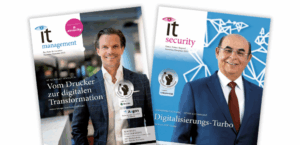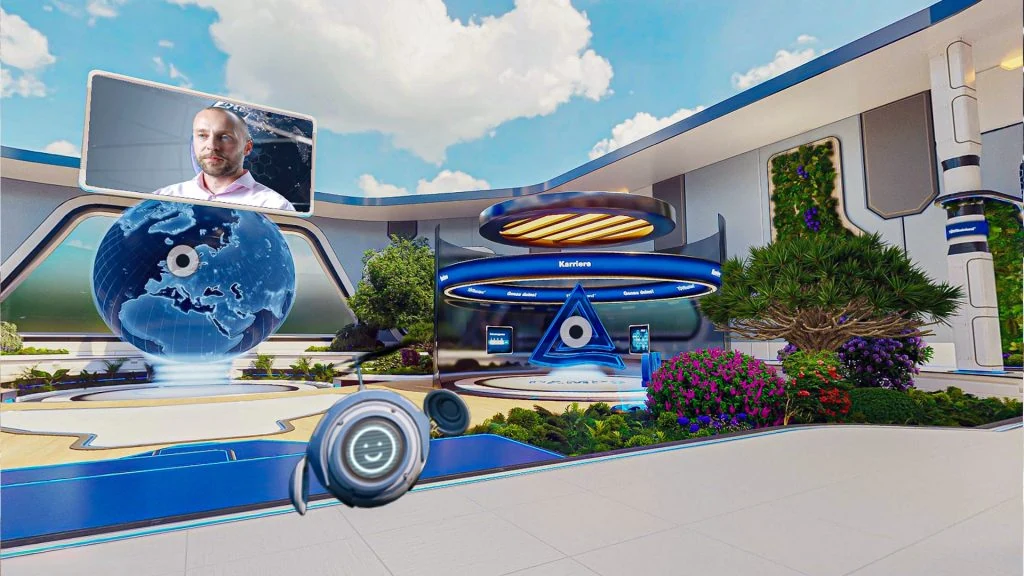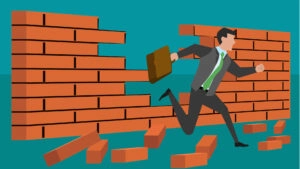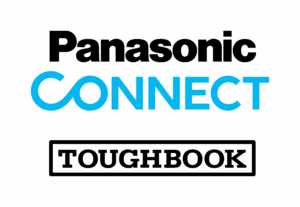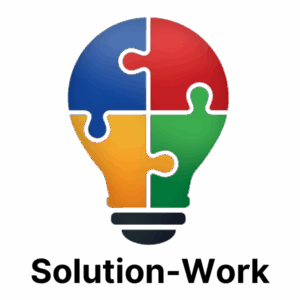What initially seemed like a technological playground has now developed into a lighthouse project: CAMP3, TUV Rheinland’s virtual platform, is a project that, given its innovative nature, is more likely to be found in start-ups than at an established TIC service provider.
TUV Rheinland explains what goals it is pursuing with the transformation project and which areas of application can already be covered with the Corporate Metaverse.
Looking back, CAMP3 is a consistent orientation towards a dynamic technological development that TUV Rheinland as a company has also been undergoing for decades. After the era of Web 1.0 (static websites with one-dimensional customer communication) and the phase of Web 2.0 with user-centricity, interactivity, social networking and collaborative work, Camp3 marks TUV Rheinland’s arrival in Web 3.0, which offers an immersive and virtual environment for a completely new learning and customer experience.
TUV Rheinland is thus underlining its claim to think the topic of training clearly into the future and its vision that relationships with customers, applicants and partners will change profoundly. Conceptually, the company has been looking at the possibility of interaction via avatars in virtual worlds for some time.
The company was already experimenting with new learning formats before coronavirus. Since the launch of its digitalization offensive, TUV Rheinland has made considerable development efforts to provide employees and customers with a richer user experience by integrating multimedia content such as videos, images and interactive applications for the training of the future. This includes formats such as the VR Safety Training Box for company safety briefings as well as the “Empower People” event, which TUV Rheinland launched in 2023. Based on Camp3, the result is a “walk-in, digital platform” in 3D format covering all aspects of lifelong learning, personnel development and health in the workplace that has attracted a lot of attention across the industry, can be scaled and expanded in a variety of ways and has already been visited by more than 10,000 users.
Easy access for “digital participation”
TUV Rheinland had no digital role models for CAMP3, at least not in a business context. When the idea was born at a marketing meeting in 2021, most of those present were initially struck by images from the gaming sector. The necessary transfer of the gaming characteristics to the corporate world was one of the biggest challenges in the project. Another was the requirement that no gadgets or equipment should be needed to enter TUV Rheinland’s corporate metaverse. The aim was to enable “digital participation” for as many people as possible.
Several factors have had a decisive influence on CAMP3’s current level of maturity:
- the interdisciplinarity of the project team
- Transparent, regular project communication
- A careful evaluation phase: What do we want with CAMP3? What should such a platform be able to do? What should it not be able to do?
- the modularity
- transparent internal communication
- the involvement of managers and employees in the test phases
- “Taking” applicants and customers into the virtual world
1. Interdisciplinarity of the project team
The project team included all key disciplines from the business division: in addition to representatives from Marketing, representatives from Business Development and Digital Learning; operational experts who were familiar with the needs of customers and were able to contribute technical content, as well as representatives from Sales. Several workshops with the specialist departments and the individual business areas ensured that the project retained its business relevance.
2. Transparent project communication
With five to 20 project participants, it is important that everyone is always on the same page. Transparent and close-meshed project communication was an absolute must in order to manage the project reliably.
3. Evaluation
The concept phase took up most of the time. As the Metaverse technology enables the comprehensive integration of content, it is tempting to write everything that seems desirable, exciting, brand-building, mandatory or simply topical into the specifications. The aim here was to set the right focus in line with the business objectives – and these were clearly defined:
- New business cases: Acquiring knowledge of “Web3” technology (metaverse spaces, NFTs, mixed reality, etc.) and identifying business opportunities through the development of new projects.
- Future Evidence: Increasing brand image & awareness as a trustworthy brand for new and existing customers. Another central concern was the ongoing modernization of the brand image, with the clear aim of consolidating and further expanding trust in TUV Rheinland’s innovative strength.
- Digital community: CAMP3 is to become an exchange and collaboration platform, a virtual home for employees; the aim is to create a cross-location national and international “digital community”.
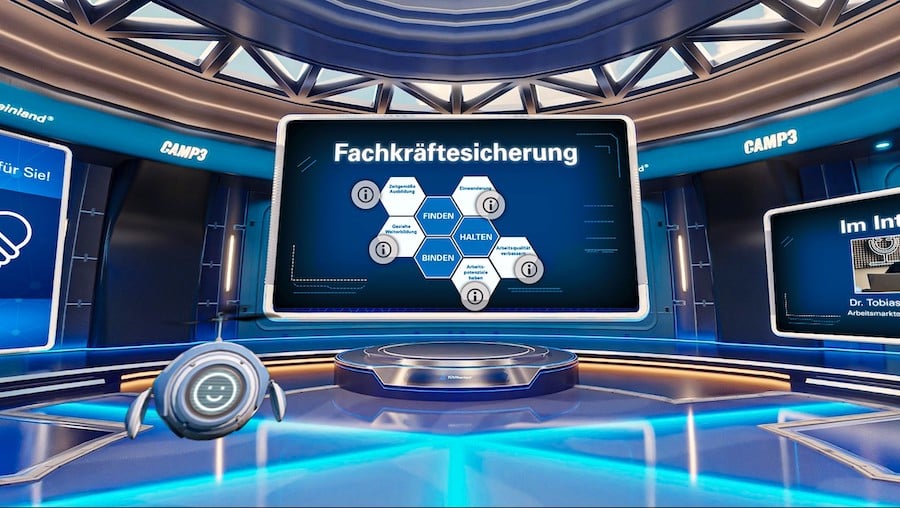
Event area: TUV Rheinland also uses the metaverse to create added value for certain virtual
events with additional content matching the topic. (Image source: TUV Rheinland)
4. Modularity
Another challenge with projects like the Metaverse is the desire to complete everything at the same time. Care and technically flawless programming take precedence over speed. TUV Rheinland therefore brought an experienced technology partner on board for the implementation.
5. Internal communication
The response to the CAMP3 project announcement within the division was initially mixed. Enthusiasm on the part of employees with an affinity for digital, cautious skepticism and even rejection and the question as to why we shouldn’t continue to use flyers on the part of others: The entire spectrum of reactions to a transformation project that was initially very abstract for many employees at all levels was evident. Regular updates on the progress of the project increasingly increased understanding of CAMP3.
6. Managers and employees become testers
Interactive sneak previews ensured that the idea of CAMP3 took on more and more shape among managers and employees alike and significantly increased identification. One challenge in particular, which was rolled out in social media spheres such as LinkedIn, increased the interaction rate among managers and employees by up to 50 percent. Since then, sales staff have also had a clear idea of how CAMP3 can act as a door opener for customers.
7. Taking applicants and customers into the virtual world
The expansion of the CAMP3 target groups from event and trade visitors to applicants and customers is a new milestone at TUV Rheinland. The company is thus responding to an important trend among the new generations: 20- to 37-year-olds have grown up with computers and are socialized in a networked world. Their representatives have a different communication behavior. They are used to sharing personal information and knowledge in a playful and non-hierarchical way and to working decentrally and virtually in networks and on projects. Their values are also based on different pillars than those of today’s second and third-level managers. The collective knowledge that they acquire in the shortest possible time via their cross-company networks helps them to do this. The design and structure of CAMP3 is based precisely on this mentality and offers added value for employees and can help to attract new employees.
In an age in which entrepreneurial innovation and economic growth are primarily based on knowledge, creativity, communication and social skills, a willingness and ability to innovate is required, as well as increased personal responsibility and openness to lifelong learning. CAMP3 offers the appropriate stage for this. TUV Rheinland demonstrates interactively and immersively how learning of the future can already succeed today, how companies and employees can benefit from it and what work-integrated learning scenarios and occupational safety of the future could look like.
www.tuv.com/camp3

